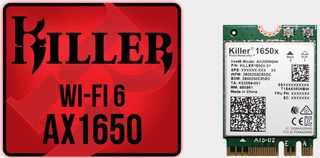Killer AX1650 Wi-Fi 6 adapter is built on Intel tech
A wireless networking solution for gamers, it aims to slay latency for critical packets.

Whenever possible, it's better to game over a wired (LAN) connection rather than using Wi-Fi, which is generally slower (depending on your distance to the router) and introduces higher latency. Being physically tethered to your router is not always convenient, though, and that's where Rivet Network's new Killer AX1650 wireless adapter might prove beneficial.
We have not had a chance to test this new adapter yet, but have spent time with previous generation Killer networking gear, with mixed results. In 2015, for example, we were of the opinion that motherboards with Killer adapters weren't worth the money. Slightly more recently, we found that a Killer NIC (network interface card) could make a big difference in some situations. Since then, we have not spent much time specifically testing with Killer gear.
There is reason to be cautiously optimistic. The Killer AX1650 uses Intel hardware and is based on the chip maker's AX200 wireless module (this is the second generation of Killer products based on Intel IP). Like the AX200, the Killer AX1650 is a Wi-Fi 6 module, otherwise known as 802.11ax, which improves on the 802.11ac (Wi-Fi 5) standard with increased throughput to accommodate more simultaneous connections, and lower latency. Check out our article on why gamers should care about Wi-Fi 6 for more details.
While the Killer AX1650 is based on Intel's hardware, it is not exactly the same as the AX200. As Rivet Networks explained to our friends at AnandTech, it baked some additional features into the AX1650, and is therefore capable of doing things that the AX200 can't.
Primary among them is the use of trained algorithms to detect types of network traffic. The Killer AX1650 uses that information to prioritize certain traffic so that packets that are sensitive to latency (such as gaming) are first in line. One of Rivet Network's claims is that the Killer AX1650 can deliver up to three times better in-game latency compared to a regular Wi-Fi module. That is not an insignificant jump, if the claim holds true.

Rivet Network also claims its wireless adapter is less taxing on the CPU, though that's probably a negligible benefit in today's multi-core landscape. Beyond gaming, Rivet Networks touts better video streaming performance—up to five times better than a regular Wi-Fi chip—and an intuitive UI for monitoring and managing network performance.
Will any of this make a worthwhile difference? The Wi-Fi 6 features certainly could, provided you own a Wi-Fi 6 router (you probably don't right now, but more options are starting to hit the market). It's the other stuff that raises a big question mark. We'll have a better answer once we spend some hands-on time with the Killer AX1650.
The biggest gaming news, reviews and hardware deals
Keep up to date with the most important stories and the best deals, as picked by the PC Gamer team.
The new module will find its way to "select high-end computers" from Alienware later this month, then at some point will be offered as a standalone M.2 module.
Paul has been playing PC games and raking his knuckles on computer hardware since the Commodore 64. He does not have any tattoos, but thinks it would be cool to get one that reads LOAD"*",8,1. In his off time, he rides motorcycles and wrestles alligators (only one of those is true).
Most Popular





